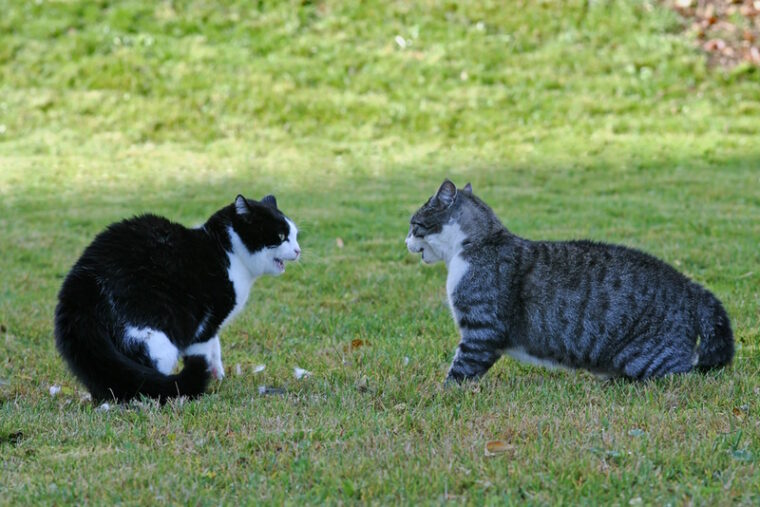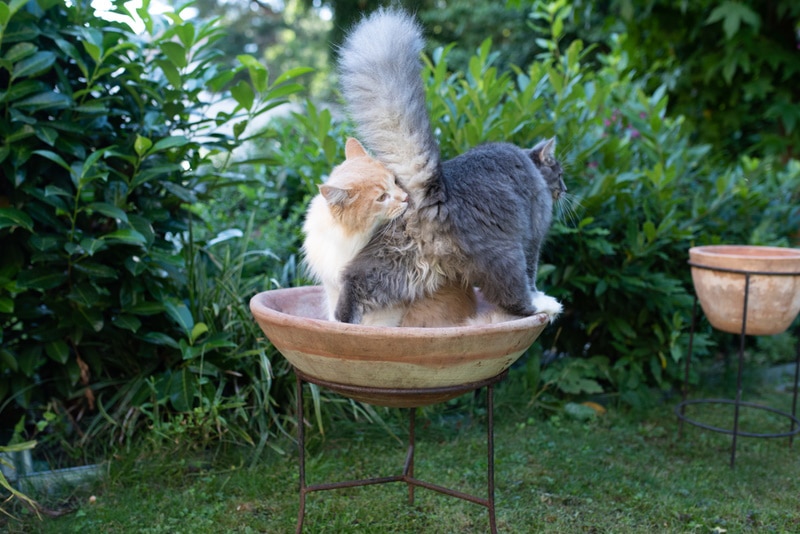
Cat parents usually know when their cat is greeting them, and they certainly have their own way of communicating what they want from their humans. Have you ever wondered how cats greet one another, however? Cats often greet each other by gently touching their noses and engaging in a bit of butt-sniffing, but how do these actions help them identify friends and strangers? We’ll discuss how cats greet one another and the reasons behind their curious greetings.
The 3 Methods of How Cats Greet One Another
1. Through Smell
One way that cats greet one another is through smell. Besides having many more smell receptors than humans, cats also have a specialized organ called the Jacobson organ. This is a secondary olfactory system that detects pheromones and sends chemical signals straight to the brain.
Every cat has scent glands that are located on its whiskers and forehead. They also have these glands on their chins, on the pads of their paws, and close to their butts. They release pheromones that other cats can smell.
These pheromones tell each cat everything they need to know about the other cats around them, including information about their health status. The cat can also determine the type of mood the other cat is in and the cat’s gender.
Butt Sniffing
Butt-sniffing is something you’ve probably seen your cat take part in when it sees another cat. The more dominant cat usually initiates this. Still, a submissive, shyer cat can refuse to participate in this getting-to-know-you ritual by just sitting down so that no butt-sniffing can occur.
Marking
If you’ve seen your cat rubbing against things, such as your furniture, or even your leg, it’s because the cat is marking that stuff, including you, as its territory. That way, when a new cat comes in, the cat can sniff those areas and know your cat is there before they even see them.
Spraying
Some cats will spray inside or urinate somewhere besides the litter box if they feel threatened to mark their territory so that other cats and animals can smell it. Cats will also spray to let other cats know they are ready to mate.

2. They Get Vocal
If you have a cat, you already know they can get pretty vocal when the need arises or just because they want to. If another cat comes into the room, and your cat makes a cute little trilling noise, it’s saying hello to its little friend.
Usually, cats meow to communicate their needs to their pet owners, though kittens meow to alert their mothers that they need her and need to be fed. Experts even think that meows have evolved since they became domesticated so that they can use the sounds to alert humans that they want food or attention.
Growling and hissing are very common vocalizations for a cat. They growl and hiss to show their displeasure and to warn other cats and animals away if they feel threatened. Your cat will do this to another cat if it doesn’t trust the other feline, but it will mostly make the trilling noise mentioned above if they consider the cat a friend.
3. Through Body Language
Another way that cats greet one another is through body language. You’ve probably seen your cat express its emotions through its tail, ears, eyes, and whiskers more than once. Cats that feel comfortable with one another tend to approach with their ears pointed just a bit forward and tails high in the air.
A cat that isn’t comfortable with another feline will often hiss and growl. Its ears will fold back against its head, and the tail will thwack against the floor as they crouch in a defensive position.
If your cat feels vulnerable around another cat, it will usually hide. A slow blink at another cat usually means your cat is up for being friends.

Which of Their Senses Is a Cats Strongest Ally?
While cats have many strong senses to speak of, their sense of smell is the one they rely on the most. It is how they identify family members, their homes, and even cats that they are friendly with. The cats’ sense of smell is 14 times stronger than ours, meaning they can detect odors we can’t and smell them miles away. They also use sound to identify family members, but their sense of smell is their biggest ally.
What Is the Best Way to Introduce Two Cats?
If you are bringing a new cat home, it is recommended to first give them some time apart so they can gradually get used to each others’ smell. Introducing objects with the other cat’s smell, paired with some treats, can do the trick. After some acclimatization time, you can allow them to greet each other. The first interactions should be closely observed and take place in a neutral space in the house. It is best to separate them after a short positive interaction time and work on gradually increasing the time together.
In Conclusion
Cats have a keen sense of smell, and they use it along with vocalization and body language to greet and communicate with other cats. If you have a cat and are introducing another cat to your household, it’s best to allow some time apart and keep an eye on the felines as they get to know one another. Just like humans, some cats just don’t get along, and there’s no rhyme or reason.
Featured Image Credit: Astrid Gast, Shutterstock







